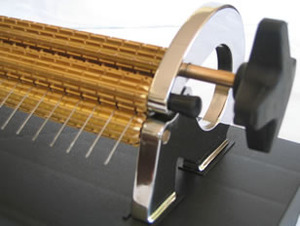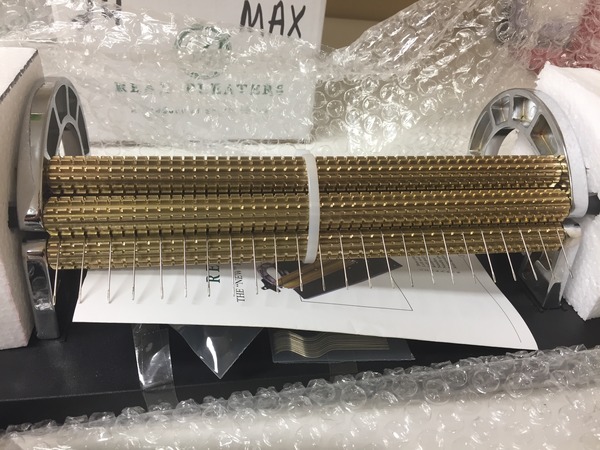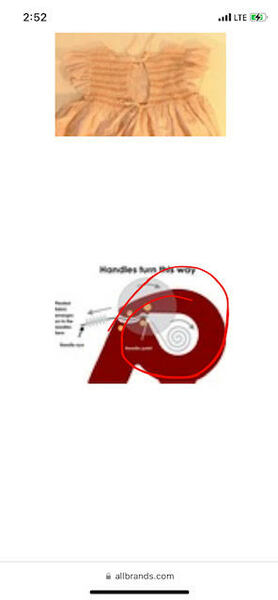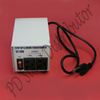Also Includes
Includes 23 Half Spaces, 34 Needles and Rows across the entire 9" pleater needle brass roll, Smock Gathering Machine, Extra 12 Needles
Note: Amanda Jane Pleaters Made in Australia are no longer being made.
AllBrands imports the Read 16, 24 and 32 Row Pleaters which will continue to be available.
Read Pleaters have heavy duty stable base, plate with anti skid rubber feet, extra large side plate opening allowing for large capacity of rolled up fabric, simple pin type roller holding system allows for quick and easy needle access, comfortable and user friendly dual handles for maximum versatility, heavy duty solid brass rollers capable of handling heavier weight fabrics.
Like the Read 32 row, the Read 24 row MAXI has been redesigned and improved offering all the same great features with the difference being the number of half rows. Half row spacing span the entire length of the rollers. Half spaces can be used as guidelines when smocking or to better hold difficult fabrics that tend to open and bubble the pleats. Pleat half spaces on light to light-medium fabric only. Remove half row needles (every 2nd needle) when pleating medium to heavy weight fabric.
Half cm spacing across the entire width of the roller (47 needles). Half-spaces can be used as guidelines when smocking and to improve holding onto difficult fabrics which bubble (no body to the fabric, pleat collapses type fabrics). The MAXI can also be used as a Regular pleater (24 needles) by removing the half-space needles (every other needle)--needle spacing is then 3/8" apart. Heavy-duty stable base-plate with anti-skid feet. Extra large side-plate opening allowing for large capacity of rolled-up fabric on the dowel. Simple, pin-type roller holding system allows for quick and easy needle access. Comfortable and user-friendly dual handles for maximum versatility. Heavy-duty solid brass rollers. Capable of handling some heavy-weight fabrics, plus most lightweight fabrics.
- 24 row pleater has 24 needles
- plus 23 half spaces and needles, totaling 47 needles
- Brass rollers pleats 12 inch width of fabric
- Metal end brackets to match brass rolls
- Left and right hand turning knobs
- Mounted on base
- Made in South Africa
- Uses New Style READ Needles Only!
- The roller pin device is used in our new range 24 & 32-Row pleaters, whereas the 16-Row uses the original system which has two securing screws, which need to be loosened but not removed, in order to take out the removable roller to clean.
South African Craft Magazines “Stitches” Article about the Read Pleater Company (.PDF)
- US Warranty 1 year parts, 90 days labor on defects in materials and workmanship.
- Non-US Warranty: 30 days parts and labor
Click HERE for Instruction Manual Sheet for New Style Read Pleater Machines
- 24 needles installed across full width of rollers t
- 3.8 pleats per inch
-heavy base plate with anti-skid feet
-side plates allow large capacity of rolled-up fabric
-simple pin-type roller holder system allows quick & easy needle access
-comfortable dual handles for maximum versatility
-solid brass rollers
Pleating 101 by Laurie Anderson, Pleating Fabrics for Hand Smocking
The 24-Row Regular, 24-Row Maxi and 32-Row pleaters have the following specifications:
- Heavy-duty stable base-plate with anti-skid rubber feet
- Extra large side-plate opening allowing for large capacity of rolled-up fabric
- Simple, pin-type roller holding system allows for quick and easy needle access
- Comfortable and user-friendly dual handles for maximum versatility
- Heavy-duty solid brass rollers
- Capable of handling heavier weight fabrics
 Simple pin-type roller holding system allows for quick and easy needle access. User-friendly handles.
Simple pin-type roller holding system allows for quick and easy needle access. User-friendly handles.
 24-Row MAXI Read Pleater
24-Row MAXI Read Pleater
 Made in South Africa
Made in South Africa
 The Maxi has half spaces all the way across
The Maxi has half spaces all the way across
 (Q) I’m asking how much space is here in this circle. This will determine how much fabric can be smocked at a time.
(A) At least 1" diameter of rolled fabric added to our magnetic feed rod or wooden dowel. There is also at least a 1" diameter allowance for fabric rolled up inside the pleater end brackets, on our magnetic feed rod below or on a wooden dowel.
You could mount a fabric roll further back on separate brackets if you need more fabric roll diameter. AllBrands.
(Q) I’m asking how much space is here in this circle. This will determine how much fabric can be smocked at a time.
(A) At least 1" diameter of rolled fabric added to our magnetic feed rod or wooden dowel. There is also at least a 1" diameter allowance for fabric rolled up inside the pleater end brackets, on our magnetic feed rod below or on a wooden dowel.
You could mount a fabric roll further back on separate brackets if you need more fabric roll diameter. AllBrands.
As previously advised, we have been through some unprecedented political turmoil and difficult times in South Africa. We had to close the factory for a while until the crisis subsided and our staff could return to work safely. However, some of our sub-contractors/suppliers were rather badly affected, which in turn affected the costing of various items to Read Pleaters. All this has affected our manufacturing, hence the more than usual annual price increase that we had anticipated. The one positive aspect is that we no longer supply the extra needles with the Maxi, so there was a saving there. Read in South Africa, August 2021
To replace the needles, remove the top front roller by removing the pins on each side. Lay the needles in the grooves with the tips going DOWN between the two back rollers and the curve laying over the lower front roller. It is helpful to lean the pleater back and prop it up by putting something under the front of the pleater to help keep the needles in place until the upper front roller is replaced and the pins are re-inserted into each end.
Which fabrics can I pleat?
Pre-washed Batiste is prefered. Other fabrics will have to be tested. The more needles and the heavier the fabric, the greater the chance of breaking needles.
I was told you are the expert regarding Read pleaters at your company. I have an old Read 24 needle pleater and I understand the replacement needles are not the same size as the original needles. Will the replacement needles work if I change all 24 as long as they are made by Read? Please advise and if you think they will work I will order them from you. Sylvia
John, the current 24/32-row Read needles will fit all the 24 & 32-Row pleaters, with one exception – there are some very old 24 & 32-Row pleaters still in use that have a different needle. This all happened over 30 years ago and I have not been able to establish exactly how many of these old pleaters were made at the time. These old pleaters used a +/- 1cm longer needle and the curvature varied slightly from our current needles. I must stress that there are very few of those pleaters still around. It is very difficult to distinguish these old pleaters from the later ones. Al at Read
Sylvia, unless your Read 24 Row Pleater is over 30 years old, the current needles should work at Pack of 12 Needles for Read 24 and 32 Row Pleaters, are larger than the Read 16 Row Pleater Needles. John
What do I do if my needles are snagging?
Remove all the needles and make sure that it doesn’t snag without the needles. If it does not, then the rollers are damaged. If the rollers run freely without needle, compare the needles side by side laying on the table to see if any are bent. Discard bent needles and start putting the needles back a few at a time and try to identify where the snagging starts.
How should I lubricate the pleater?
Periodically (depending on how much you use it), remove the needles and the rollers by taking off the handles and taking out two screws on one side of the bottom. Clean holes and end pieces of the rollers with a soft cloth. Lubricate sparingly with Sewer's Aid, Silicone lubricant (or sewing machine oil). The silicone will be less likely to stain your fabric. Put the pleater back together and run some paper towels or cotton fabric through to remove any excess lubricant before pleating your garment.
Our customer is pleating on corduroy, and they were wondering if you might make a needle that works on heavier weight fabrics. She buys many read pleaters from us. If not, do you have any suggestions for material with that texture, and weight to prevent breaking needles?
We have found that light weight corduroys are not really a problem to pleat, but there is obviously a limit somewhere along the line, which can only really be established by trial and error. As usual, it is always important to prepare any difficult fabrics by removing any starch beforehand. It also helps with difficult fabric to pleat a piece of kitchen wax paper through the pleater which leaves a thin film of wax on the needles and this helps with the pleating process. Regarding the needles, we only have our standard thickness of needles available. We are sometimes asked if we have thicker needles available, but we believe that as these would be more difficult to push through the fabric, they would probably be of no help.
How much oil is required?
Quite right, only a drop of oil is required, which is what we used to do – a little at both ends of each roller. However, it is very easy to overdo it so since January we have changed that and now only the removable pin that holds the removable roller in place gets a very small drop. Its purpose is to facilitate getting the pin in and out of the side plate. We believe this will eliminate the problem.
The suggestion to blow compressed air onto the rollers will thin the film of oil out but actually won’t remove it. Removal requires a liquid degreaser. Industrial degreasers are the best but I don’t suggest that they buy one specially for this purpose. A domestic/kitchen liquid degreaser will do the job. Follow the supplier’s application instructions, wash off the rollers with warm water and allow them to dry out completely. Washing will not require taking the pleater apart and will not cause any damage. It may make the locating pin a bit difficult to remove but a drop of oil will sort it out. If so, pull the pins out just far enough to expose the rubber rings, apply a tiny amount of oil and push the pins back into place.
Dear John ! Thank you for your kind contact. The Smocking Pleater arrived quickly. I will contact you if there is a question. Best regards. Shoko mimura
Violetta B, Chesapeake VA
I will look to your company for future purchases. Everything was great. Thank you. Vi
Carol S, Prosperity SC
I was very much impressed with the communication and customer service I received while making my purchase! A company that responds quickly to your questions.....this was the superb type of service I received from ALLBRANDS!!!!l Thank you so much for a pleasant purchasing experience! Carol Smith
Read Pleaters, South Africa
It is very difficult to recommend which fabrics are suitable for pleating and which are not, due to the wide variety of fabrics available, all with different weave density, etc. Most cotton and polycotton fabrics are usually okay to pleat, but 100% man-made polyesters are a problem. You ask about pleating velvet, which can be difficult, depending on the weight. A soft velvet is generally okay. There is really only one way to find out and that is to try out a small sample of fabric. A general tip with difficult fabrics, is to pleat a piece of kitchen wax paper first, which leaves a fine layer of wax on the needles and it therefore makes it easier to pleat difficult fabrics. Another important issue is that fabrics with a lot of starch need to be pre-washed with a fabric softener. It is normally accepted that our 24/32-row range of pleaters, with their four big size rollers, can handle difficult/thicker fabrics better than most other pleaters.
Redonna, Tennessee
Other than the backorder on the split 2 magnetic feed bar rods, it was great. It came quickly. I'd order again.
Kathleen, California
Delighted with the product and your service. Thank you. I will let all my friends know to check with you before they purchase in the future
Sandy, Arkansas
Great Service Rapid receipt of shipment Good to do business with you Thanx
Lorene, Louisiana
Over the last 3 months I have ordered many things from Allbrands.com and I have been very pleased with the service.
Faith, New York
Thank you for excellent customer service. I have bought several items from Allbrands online and have been very happy with each transaction. My pleating machine and DVD arrived last week in excellent condition. I have already started several pleated smocking projects. Thanks!
Pam, Alabama
This is a wonderful company with helpful employees and the best prices. I've already recommended this site to several friends. I couldn't be happier with my new Read Pleater!! Thanks again! Blessings, Pam
Cheryl Johansen, Creative Smocking
First, all fabrics pleat differently and not all fabrics are intended to be pleated by a pleater, any brand, any size. The easiest fabrics to pleat are batistes and broadcloths, which have been pre-washed to remove the sizing (stiffness of the fabric). Fabrics other than these two types are at your mercy, as the pleater manufacturers (all) design and test the pleaters to work only with batiste and broadcloth. This is not to say that any given pleater won't pleat other fabrics, just might have difficulties doing so. So what type of fabric have you been attempting to pleat? Needles. The needles bend and break just like your sewing machine needles. If you feed a questionable fabric through the pleater, chances are any or some or all of the needles are now ever-so-slightly bent and will not necessarily pleat perfectly from that point on even if pleating with the lightest weight batiste. When the needles bend, they're bent and not suitable for pleating. Dowel. Are you using a dowel to wind your fabric around for pleating? Absolutely mandatory. The dowel can be anything from a 3/8" wooden dowel purchased at a place like Home Depot to one of a couple dowels available in the market place for pleating, such as the Magnetic Dowel or The Pleater Dowel. It is an absolute necessity to keep the fabric tight/taut around the dowel as the fabric feeds into the back of the pleater, if not, air bubbles of fabric (bubbles-bumps) will form as the fabric feeds thru the pleater. If there is an air bubble, the needle needing to grasp the fabric at that point will have nothing to grab because the fabric is a bubble of air. Also necessary to pleat very slowly, pulling the pleated fabric off the needles and down the gathering threads about every 3 turns. The more fabric that builds on the needles, the more likely the needles will break--too much pressure on the needles. Threads. You can use any thread from regular weight sewing machine thread to lightweight quilting thread. DO NOT USE thread heavier than LIGHTWEIGHT QUILTING THREAD, as the thread will be difficult to get thru the eye of the needle and make it difficult to run the needle through the fabric when pleating. I do not know if you have personally taken the needles out of the pleater, however, there is a right and wrong way to put the needles back into the pleater. If you have taken any needles out make sure you get them back in "pointed tip DOWN", plus the two "side plugs" (look like gun bullets) must be in the pleater properly too--tightly. Rollers. There is a right and wrong way for the rollers to fit in the pleater. The removable roller (which you remove to replace needless) has a right and left. Make sure you put it back in the pleater the way it arrived and not the opposite direction. On the Little Amanda this is difficult to tell which was right and which was left, as the entire roller is made up on 1/2 space rows, unlike the other size pleaters except for the Super AJ. Needles and Rows for Smocking. Only pleat with the exact number of needles you require for your smocking piece; remove all other needles. Leaving the excess needles in the pleater will put HOLES in your fabric. BEGINNING PLEATING INSTRUCTIONS: Start with a scrap of fabric about 6" x 4", preferably the same fabric you intend to pleat your first project. DO NOT THREAD ANY NEEDLES. Roll the scrap of fabric around a dowel. Feed the fabric on the dowel into the back of the pleater. Begin pleating. When you can successfully pleat this scrap of fabric, proceed on to a larger scrap of fabric without threading the needles again. Mission accomplished, thread 4-5 needles and using a scrap of fabric again, pleat. Continue practicing in this method until you can pleat fabric with the needles threaded until the fabric pleats perfect pleats! You are now ready to begin your first project! DO NOT BEGIN WITH A BISHOP!!!! These are tricky even for the most experienced pleater/smocker! If all this fails for you, there is the "bible of pleating" called The Pleater Manual. You can purchase one thru Allbrands. The book is 72 pages in length and covers every question you might have. You should have received Allbrands Pleating DVD when you purchased the pleater--I hope you've had time to watch it. If all this fails, there is an additinoal pleating DVD which you can also purchase through Allbrands called the Pleating Video.


















